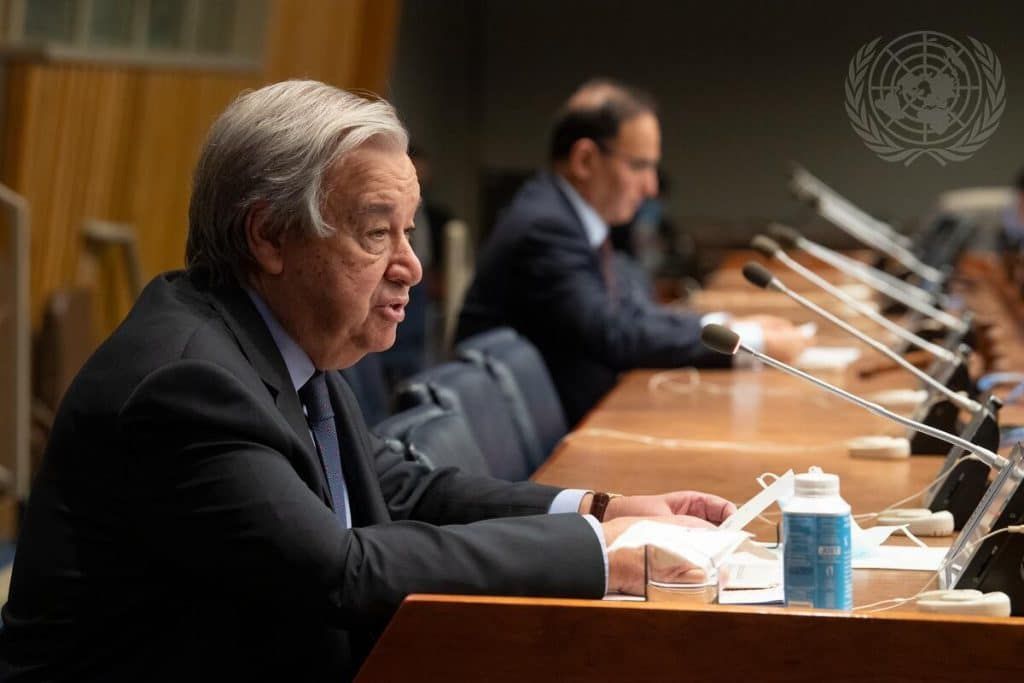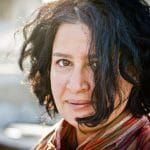Pathways to a WMD-free zone in the Middle East
By Leonardo Bandarra, Sharon Dolev | December 2, 2021
 Secretary-General António Guterres addresses the Conference on the Establishment of a Middle East Zone Free of Nuclear Weapons and Other Weapons of Mass Destruction on November 29, 2021. UN Photo/Eskinder Debebe
Secretary-General António Guterres addresses the Conference on the Establishment of a Middle East Zone Free of Nuclear Weapons and Other Weapons of Mass Destruction on November 29, 2021. UN Photo/Eskinder Debebe
This week, the Conference on the Establishment of a Middle East Zone Free of Nuclear Weapons and Other Weapons of Mass Destruction (WMD) is holding its second meeting at UN headquarters. Despite the absence of Israel and the United States at the conference and at an earlier session in 2019, this year’s meeting could lead to significant progress toward a WMD-free zone given recent changes in the Middle East security situation.
Those changes include the Abraham Accords formalizing relations between Israel and four other countries in the proposed zone, the new government coalition in Israel, the changing US policy toward the Iran nuclear deal, the rapprochement between Tehran and Riyadh, and progress on Libyan peace talks. These events have improved the prospects for dialogue among key actors in the region.
Enormous challenges still remain, and at the moment it is difficult to envision any near-term agreement in which Israel would be willing to part with its nuclear weapons. Nevertheless, we see several possible pathways for moving the region toward a treaty establishing a WMD-free zone in the medium and long term. As of now, such a treaty is the best shot at a lasting solution to proliferation concerns in the Middle East.
A history of dialogue. Achieving a stable environment in the Middle East has been an international political priority for years. Talks on the elimination of WMD from the Middle East date back to 1974, when Iran and Egypt sponsored a resolution calling for a nuclear-weapon-free zone in the region. In 1990, Egypt expanded the scope of the resolution to cover all WMD and their delivery systems. Between 1991 and 1995, Israel and its Arab neighbors held multilateral negotiations known as the Arms Control and Regional Security working group. In 1995, countries in the region included progress toward a WMD-free zone (WMDFZ) as a conditional part of a package extending the Nuclear Non-Proliferation Treaty indefinitely.
After the treaty forum failed to advance toward a WMDFZ, the UN General Assembly established the conference that met two years ago and is meeting again this week.
The complete elimination of all WMDs from the Middle East would ensure further dialogue in the region and build trust among countries. Such elimination should be based on enforceable and legal grounds and should include a regional organization that ensures compliance with the peaceful uses of dual-use technologies and serves as a forum where countries can convene periodically. This endeavor should address all three categories of WMD and build on and expand existing verification systems, using and reinforcing expertise from international organizations such as the International Atomic Energy Agency and the Organization for the Prohibition of Chemical Weapons.
Adhering to international regimes. Eliminating all WMD through a regional and institutional structure would be a revolutionary endeavor. There are currently nine Nuclear-Weapon-Free Zones established under international law, five of which are in populated areas, but none of these zones cover non-nuclear types of WMD, let alone create mechanisms to avoid their proliferation. However, there are a number of multilateral nonproliferation treaties that have laid the foundation for a future regional treaty architecture in the Middle East.
Those overarching treaties include the Chemical Weapons Convention, the Biological Weapons Convention, the Nuclear Non-Proliferation Treaty, the Comprehensive Nuclear Test Ban Treaty, and the Treaty on the Prohibition of Nuclear Weapons, as well as requirements from other legally binding instruments, such as UN Security Council Resolution 1540 regarding the nonproliferation of WMD. Almost all Middle Eastern countries are already parties to most of those treaties—or have at least signed them. However, some countries bind their accession to regional rivals doing the same or to a broader definition of peace in the region. Basically, nobody wants to be the first to give up any perceived advantage. A fast and effective negotiation, and subsequent establishment of a WMD-free zone, offers a way out of this conundrum.
Imagining the zone. Creating a WMDFZ in the Middle East is one of the rare items of consensus among countries in the region. How to achieve it is, nonetheless, unclear. Some experts argue for a series of topic-specific treaties—starting, for example, with a prohibition on chemical or nuclear weapons, or a limited sub-regional WMDFZ covering only the Persian Gulf. Although that approach has some advantages, it risks dividing energies and singling out specific countries in the process. A nuclear-free-only zone would, for example, be promptly rejected by Israel. A chemical-only prohibition would likely be rejected by countries, such as Egypt, that bind their accession to the Chemical Weapons Convention to Israel’s renunciation of nuclear weapons. A WMDFZ covering Gulf States only would leave aside relevant players like Egypt, Israel, Syria, and Libya.
A more promising solution would be to stick to a wide-ranging regional treaty that would cover all three WMD categories and create an institution to ensure compliance with the treaty’s obligations. This umbrella would cover, as agreed in the UN Conference, all 22 members of the Arab League plus Iran and Israel.
Countries could follow three pathways in negotiating an effective WMDFZ treaty. Each of these models would include a governance system capable of coordinating verification activities in multiple facilities, avoiding duplication of activities with other international organizations, and implementing compliance mechanisms to prevent cheating. Furthermore, all three pillars—nuclear, chemical, and biological—would be addressed with a review and verification system that aligns with international mechanisms to verify and inspect nuclear, chemical, and biological materials (although the latter mechanism hasn’t yet been agreed on). The models differ mostly in one central aspect, namely the role of the new regional organization that would be created by the treaty.
The first model is based on an (almost) exclusive reliance on international inspections and safeguard regimes already established by the International Atomic Energy Agency and the Organization for the Prohibition of Chemical Weapons. A regional Middle Eastern organization would serve as a coordinator between these international agencies and a registry. This is how nuclear-weapon-free zones like those in Central Asia, Mongolia, and the South Pacific currently work. The lower institutionalization of this model makes it budget-saving and relatively easy to implement. Its main disadvantage is that it does not address the imbalance between existing verification systems for different categories of WMDs. Also, this approach would be a missed opportunity to create a forum that all Middle Eastern countries can join on a standing basis and thereby create future trust-building measures.
The second model would add to existing international regimes by creating a regional commission to regulate WMD-related dual-use technology. This commission could also request special inspections by international organizations and appoint members to verification missions—or even create its own verification mechanism if necessary. Examples of this approach include the nuclear-weapon-free zones in Africa, Southeast Asia, and Latin America. In the first two cases, the regional commission is closely associated with existing international organizations—the African Union and the Association of Southeast Asian Nations—whereas the third zone created its own Agency for the Prohibition of Nuclear Weapons in Latin America and the Caribbean. The main advantage of a regional commission is that it binds countries together in a volatile region where there are typically few other opportunities to convene. The full application of this model could, however, be harmed by the lack of an international mechanism to inspect biological materials, despite ongoing changes in the Biological Weapons Convention peer-review process.
The third model goes a step further by establishing a regional verification, safeguards, and compliance system. In the nuclear realm, a nuclear-weapon-free zone with a full regional safeguards system is nonexistent, notwithstanding the bilateral safeguards agency between Brazil and Argentina. The main disadvantages of this model are the cost of establishing a new system and the need to build bureaucratic capacity. It has the advantage of creating new institutional mechanisms that increase countries’ accountability and mutual trust. It would make the Middle East a leader in the creation of regional solutions to chemical and, most innovatively, biological threats.
An all-encompassing WMDFZ treaty for the Middle East, grounded on a regional organization capable of monitoring the peaceful uses of dual-use technologies, is a worthwhile project that would contribute to achieving stability in the region and beyond. It would turn the Middle East from a region of global concern, where chemical weapons have been widely employed and where a potential nuclear-arms race could be unleashed at any moment, into a region with a legally binding and humanitarian-based regional security system, capable of dissolving former rivalries.
This week’s meeting presents a rare opportunity for progress, which can be achieved through multiple pathways. This is all possible if we keep looking for the solutions instead of obsessing over the obstacles.
The authors are part of a group of experts and practitioners that is developing models for a WMDFZ Draft Treaty under the auspices of the Middle East Treaty Organization.
Together, we make the world safer.
The Bulletin elevates expert voices above the noise. But as an independent nonprofit organization, our operations depend on the support of readers like you. Help us continue to deliver quality journalism that holds leaders accountable. Your support of our work at any level is important. In return, we promise our coverage will be understandable, influential, vigilant, solution-oriented, and fair-minded. Together we can make a difference.
Keywords: WMD-free zone, weapons of mass destruction
Topics: Biosecurity, Chemical Weapons, Nuclear Risk, Nuclear Weapons, Opinion
















At the conclusion of the conference (a day after this Bulletin article was published), participants adopted a report and rules of procedure for moving forward: https://www.un.org/press/en/2021/dc3840.doc.htm
How shameful that the United States would not participate in even talking about the possibility of a nuclear-free zone (calling it “WMD” dilutes the real point). Yes, it’s an unrealistic possibility for now. But is it realistic to expect that Israel will indefinitely remain the only country in the Middle East armed with nuclear weapons? Can we not see beyond our nose?